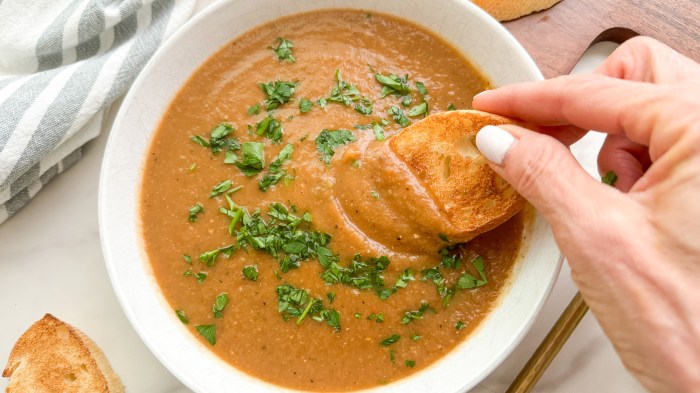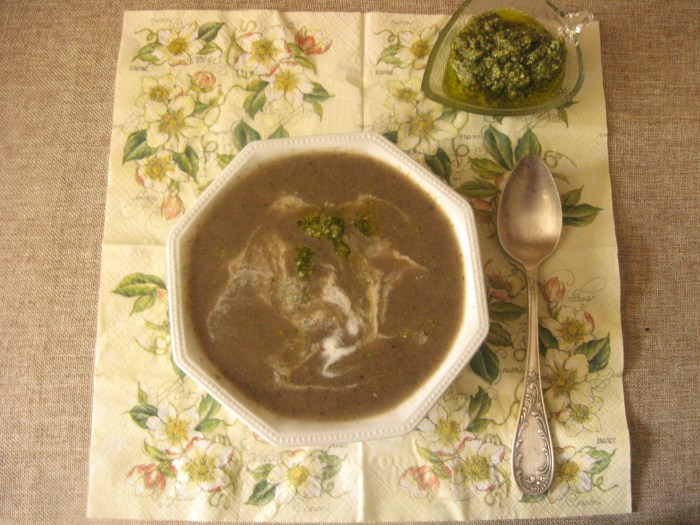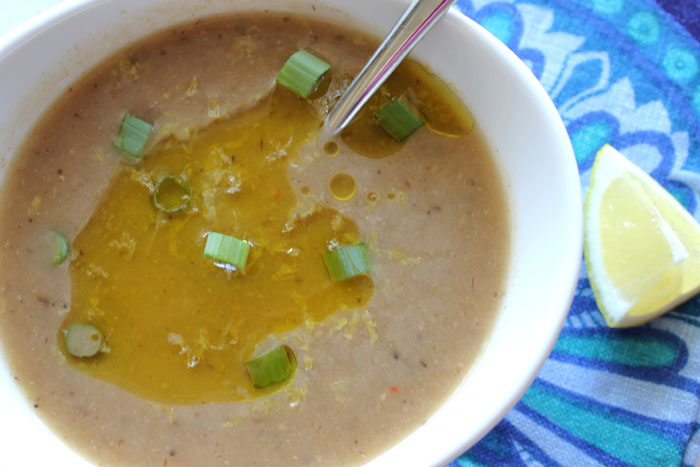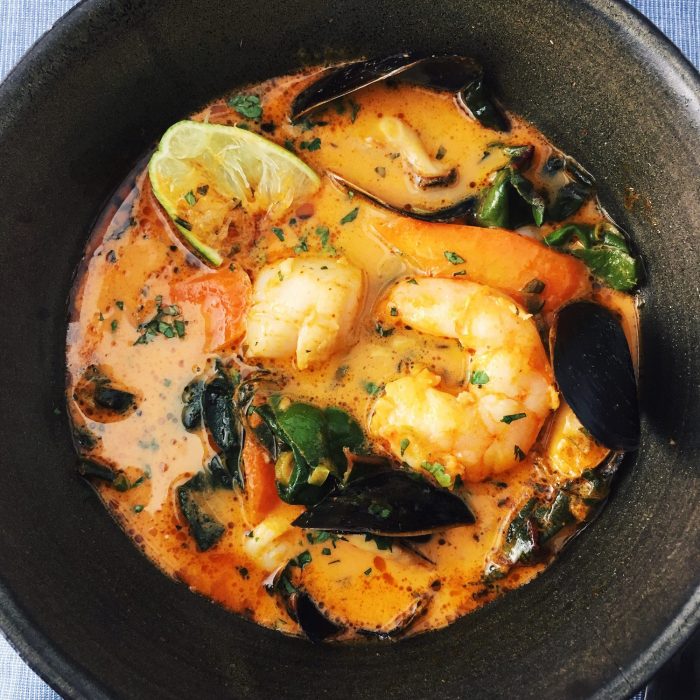Eggplant Soup Variations

Source: tastingtable.com
Recipe eggplant soup – Eggplant, with its versatility, lends itself beautifully to a range of flavor profiles. From the bright, herbaceous notes of the Mediterranean to the umami richness of Asian-inspired soups, and the comforting creaminess of classic styles, eggplant soup offers endless culinary possibilities. Below, we explore three distinct variations, each highlighting unique ingredients and cooking techniques.
Three Eggplant Soup Recipes
| Name | Ingredients | Instructions | Serving Suggestion |
|---|---|---|---|
| Mediterranean Eggplant Soup | Eggplant, diced tomatoes, garlic, onion, vegetable broth, lemon juice, Kalamata olives, feta cheese, fresh oregano, olive oil | Sauté onions and garlic, add eggplant and tomatoes. Simmer until eggplant is tender. Blend until smooth. Stir in broth, lemon juice, olives, and oregano. Garnish with feta. | Served warm with crusty bread for dipping. |
| Asian-Inspired Eggplant Soup | Eggplant, ginger, garlic, soy sauce, sesame oil, shiitake mushrooms, green onions, coconut milk, rice noodles | Roast eggplant until tender. Sauté ginger and garlic, add mushrooms and eggplant. Stir in soy sauce, sesame oil, and coconut milk. Simmer until flavors meld. Serve over rice noodles, garnished with green onions. | Served hot as a main course with steamed rice. |
| Creamy Eggplant Soup | Eggplant, potatoes, vegetable broth, heavy cream, nutmeg, Parmesan cheese, thyme, butter | Sauté eggplant until slightly browned. Add potatoes and broth, simmer until tender. Blend until smooth. Stir in cream, nutmeg, Parmesan, and thyme. Finish with a knob of butter. | Served warm with toasted croutons or a side salad. |
The key ingredients defining each flavor profile are: Mediterranean (lemon, olives, oregano, feta); Asian-inspired (ginger, soy sauce, sesame oil, coconut milk); and Creamy (heavy cream, nutmeg, Parmesan cheese).
Cooking methods vary: Mediterranean uses simmering; Asian-inspired employs roasting and sautéing; and Creamy utilizes sautéing and simmering before blending for a smooth consistency.
Eggplant Preparation Techniques: Recipe Eggplant Soup
Proper eggplant preparation is crucial to prevent bitterness and achieve optimal texture in your soup. This involves removing excess moisture and gently cooking the eggplant to enhance its flavor.
Methods for Preparing Eggplant
- Roasting: Roasting brings out the eggplant’s natural sweetness and creates a tender, slightly caramelized texture. High heat helps to evaporate moisture, reducing bitterness.
- Sautéing: Sautéing is a quick method for cooking eggplant, resulting in a softer texture. It’s ideal for incorporating into soups where you want the eggplant to retain some shape and not become completely pureed.
- Grilling: Grilling imparts a smoky flavor to the eggplant and creates a slightly charred exterior. This method works well for adding depth of flavor and visual appeal to the soup.
Advantages and Disadvantages of Eggplant Preparation Techniques
- Roasting: Advantages: enhances sweetness, tender texture, reduces bitterness. Disadvantages: longer cooking time.
- Sautéing: Advantages: quick cooking time, retains some shape. Disadvantages: can become oily if not properly managed.
- Grilling: Advantages: smoky flavor, attractive char marks. Disadvantages: requires specialized equipment, can be prone to burning.
Flavor Enhancement and Ingredient Combinations
Beyond the classic herbs, many other flavor combinations can elevate your eggplant soup. These additions can impact both the taste and texture, adding layers of complexity and intrigue.
Unique Flavor Combinations for Eggplant Soup
- Smoked Paprika and Chipotle Peppers: Adds a smoky heat and depth of flavor.
- Coconut Milk and Lemongrass: Creates a creamy, subtly sweet, and aromatic soup.
- Peanut Butter and Ginger: Offers a nutty, savory, and slightly spicy profile.
- Curry Powder and Cilantro: Delivers a warm, fragrant, and herbaceous taste.
- Roasted Red Peppers and Toasted Almonds: Provides a sweet, nutty, and slightly crunchy element.
Each combination impacts the soup differently; for example, the smoked paprika and chipotle peppers add a spicy kick, while the coconut milk and lemongrass offer a tropical twist. The peanut butter and ginger create a rich, savory base, the curry powder and cilantro provide a vibrant herbaceousness, and the roasted red peppers and toasted almonds add a delightful textural contrast.
Recipe with Coconut Milk and Lemongrass, Recipe eggplant soup
This recipe incorporates the coconut milk and lemongrass combination for a fragrant and creamy soup.
Ingredients: 1 large eggplant, diced; 2 stalks lemongrass, thinly sliced; 3 cloves garlic, minced; 1 can (13.5 oz) full-fat coconut milk; 4 cups vegetable broth; 1 lime, juiced; salt and pepper to taste; chopped cilantro for garnish.
Instructions: Sauté lemongrass and garlic until fragrant. Add eggplant and cook until softened. Stir in coconut milk and broth. Simmer until eggplant is tender. Blend until smooth.
Season with lime juice, salt, and pepper. Garnish with cilantro.
Serving Suggestions and Garnishes
Presenting your eggplant soup creatively can significantly enhance the dining experience. Beyond the standard bowl, consider these serving options and garnishes to elevate the visual appeal and flavor.
Creative Serving Suggestions
- Served in a Bread Bowl: A rustic and hearty presentation, perfect for a cozy meal.
- With Grilled Cheese Croutons: Adds a savory and crunchy contrast to the smooth soup.
- As a Chilled Soup: A refreshing alternative for warmer weather, ideal with a dollop of crème fraîche.
Garnishes for Eggplant Soup
| Garnish | Description of its contribution to the soup |
|---|---|
| Chopped fresh herbs (parsley, chives, dill) | Adds freshness, brightness, and visual appeal. |
| Crème fraîche or sour cream | Provides a creamy texture and tangy counterpoint. |
| Toasted nuts (almonds, walnuts) | Adds crunch and nutty flavor. |
| A drizzle of high-quality olive oil | Enhances the richness and adds visual shine. |
| Microgreens | Adds a peppery bite and vibrant color. |
Dietary Adaptations

Source: shortpixel.ai
Eggplant soup can easily be adapted to suit various dietary needs and preferences. With simple substitutions, you can create delicious and inclusive versions for vegans, vegetarians, and those following gluten-free diets.
Adapting Eggplant Soup for Different Diets

Source: robustrecipes.com
- Vegan: Omit any dairy products (like cream or cheese). Use vegetable broth instead of chicken broth. Ensure all other ingredients are plant-based.
- Vegetarian: Simply ensure that no meat or animal products are included in the recipe. Vegetable broth is a suitable alternative to chicken broth.
- Gluten-Free: Use gluten-free vegetable broth and ensure that any added croutons or bread are also gluten-free.
Vegan Eggplant Soup Recipe
Ingredients: 1 large eggplant, diced; 1 onion, chopped; 2 cloves garlic, minced; 4 cups vegetable broth; 1 can (13.5 oz) full-fat coconut milk; 1 tbsp nutritional yeast; 1 tsp smoked paprika; salt and pepper to taste.
Instructions: Sauté onion and garlic until softened. Add eggplant and cook until tender. Stir in vegetable broth, coconut milk, nutritional yeast, and smoked paprika. Simmer until flavors meld. Blend until smooth.
Season with salt and pepper.
Visual Descriptions of Eggplant Soup
The visual appeal of a well-made eggplant soup is as important as its taste. A successful recipe should exhibit specific characteristics in terms of color, texture, and aroma.
Ideal Characteristics of Eggplant Soup
A well-made eggplant soup should have a rich, deep purple hue, possibly with flecks of other vegetables depending on the recipe. The texture should be smooth and creamy, yet retain some slight body. The consistency should be neither too thin nor too thick, allowing for easy pouring but with enough substance to coat the spoon. The aroma should be warm, inviting, and slightly smoky, with hints of the herbs and spices used.
Imagine the comforting scent of roasted eggplant mingling with the subtle sweetness of roasted garlic and the aromatic depth of chosen spices. A bowl of eggplant soup should present a visually appealing contrast of colors and textures. The deep purple of the eggplant might be offset by the bright green of fresh herbs or the creamy white of coconut milk.
The smoothness of the soup itself might be contrasted by the crunch of toasted nuts or the crispness of croutons. The overall presentation should be inviting and appetizing, encouraging the diner to savor each spoonful.
A delicious recipe for eggplant soup often features roasted eggplant for a smoky depth of flavor. This hearty soup fits perfectly within a plant-based diet, and if you’re looking for more inspiration, check out this excellent resource for plant based diet soup recipes to expand your culinary horizons. Returning to our eggplant soup, remember to simmer it gently to allow the flavors to meld beautifully.
Popular Questions
Can I use frozen eggplant in eggplant soup?
Yes, but thaw it completely and squeeze out excess moisture before using to prevent a watery soup.
How long can I store leftover eggplant soup?
Store leftover soup in an airtight container in the refrigerator for up to 3-4 days.
Can I make eggplant soup ahead of time?
Yes, the soup can be made a day or two in advance and reheated gently. The flavors will deepen over time.
What type of eggplant is best for soup?
Globe eggplants are generally preferred for their mild flavor and creamy texture when cooked.


